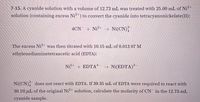
Chemistry
10th Edition
ISBN: 9781305957404
Author: Steven S. Zumdahl, Susan A. Zumdahl, Donald J. DeCoste
Publisher: Cengage Learning
expand_more
expand_more
format_list_bulleted
Question

Transcribed Image Text:7-15. A cyanide solution with a volume of 12.73 mL was treated with 25.00 mL of Ni2+
solution (containing excess Ni?+) to convert the cyanide into tetracyanonickelate(II):
4CN
+ Ni²+ → Ni(CN);
The excess Ni²+ was then titrated with 10.15 mL of 0.013 07 M
ethylenediaminetetraacetic acid (EDTA):
Ni?+ + EDTA'- → Ni(EDTA)²-
Ni(CN); does not react with EDTA. If 39.35 mL of EDTA were required to react with
30.10 nL of the original Ni²+ solution, calculate the molarity of CN in the 12.73-mL
cyanide sample.
Expert Solution
This question has been solved!
Explore an expertly crafted, step-by-step solution for a thorough understanding of key concepts.
This is a popular solution
Trending nowThis is a popular solution!
Step by stepSolved in 3 steps

Knowledge Booster
Similar questions
- 8.00 mL of 5.00 x 10³ M Fe(NO3)3 (5.00 times 10 to the minus 3rd power MFe (NO3)3) is added to 4.00 mL of 4.00 x 103 M KSCN (4.00 times 10 to the minus 3rd power M KSCN) along with 6.00 mL of water. The concentration of [F e(SCN)2+] was found to be 2.00 x 10-4 M (2.00 times 10 to the minus 4th power M) at equilibrium.How many moles of F e3+ are present in the solution at equilibrium? Express your answer as a decimal number (no exponents). Your Answer: Answer unitsarrow_forwardA 100.0-mL sample of spring water was treated to convert any iron present to Fe2+.Titration with 35.00-mLof 0.002345 M K2Cr2O7 resulted in the reaction6Fe2+ + Cr2O72- + 14H+ 6Fe3+ 1 2Cr3+ + 7H2OThe excess K2Cr2O7 was back-titrated with 8.32 mL of 0.00897 M Fe2+ solution.Calculate the concentration of iron in the sample in parts per million.arrow_forward3. Calculate the pZn of solutions prepared by adding 15.0, 25.0, and 35.0 mL of 0.100M EDTA to 50.0 mL of 0.00500M Zn²+ in 0.100M NH3 and 0.175M NH4Cl buffered to a pH of 9.0.arrow_forward
- Hh.88.arrow_forward7.00 mL of 6.00 x 103 M Fe(NO3)3 (6.00 times 10 to the minus 3rd power MFe (NO3)3) is added to 4.00 mL of 8.00 x 103 M KSCN (8.00 times 10 to the minus 3rd power M KSCN) along with 7.00 mL of water. The concentration of [F e(SCN)2+] was found to be 1.00 x 103 M (1.00 times 10 to the minus 3rd power M) at equilibrium. How many initial moles of SCN (SCN minus) are present in the solution? Express your answer as a decimal number (no exponents). Your Answer: Answer unitsarrow_forward9.00 mL of 6.00 x 103 M Fe(NO3)3 (6.00 times 10 to the minus 3rd power M Fe (NO3)3) is added to 5.00 mL of 6.00 x 10-3 M KSCN (6.00 times 10 to the minus 3rd power M KSCN) along with 4.00 mL of water. The concentration of [F e(SCN)2*] was found to be 1.00 x 10-4 M (1.00 times 10 to the minus 4th power M) at equilibrium. How many moles of SCN" (SCN minus) are present in the solution at equilibrium? Express your answer as a decimal number (no exponents). Your Answer: Answer unitsarrow_forward
- What is the concentration of S2- in equilibrium with MnS(s) (Ksp [S²] = M = 4.6 x 10-¹4) and 0.098 M Mn²+?arrow_forward25.00 mL 0.01000 M Ni2+ is titrated with 0.01000 M EDTA in a solution buffered to pH 5.0. Given that the formation constant for the Ni-EDTA (NiY2–) chelate is 4.2 x 1018 and the 4 value at pH 5.0 is 3.54 x 10–7 An indicator (Ind) forms a metal-indicator complex with Ni2+ (NiInd), giving aconditional formation constant of 1.00 x 108 at pH 5.0. It is generally assumedthat human eyes can detect about 1 part of one color in 10 parts of another;therefore, the first discernible color change will occur when the [NiInd]:[Ind]ratio changes from 10 to about 0.1.arrow_forward25.00 mL 0.01000 M Ni2+ is titrated with 0.01000 M EDTA in a solution buffered topH 5.0. Given that the formation constant for the Ni-EDTA (NiY2–) chelate is4.2 x 1018 and the 4 value at pH 5.0 is 3.54 x 10–7. Explain briefly why EDTA is an important reagent used in complexometrictitrations.arrow_forward
arrow_back_ios
arrow_forward_ios
Recommended textbooks for you
 ChemistryChemistryISBN:9781305957404Author:Steven S. Zumdahl, Susan A. Zumdahl, Donald J. DeCostePublisher:Cengage Learning
ChemistryChemistryISBN:9781305957404Author:Steven S. Zumdahl, Susan A. Zumdahl, Donald J. DeCostePublisher:Cengage Learning ChemistryChemistryISBN:9781259911156Author:Raymond Chang Dr., Jason Overby ProfessorPublisher:McGraw-Hill Education
ChemistryChemistryISBN:9781259911156Author:Raymond Chang Dr., Jason Overby ProfessorPublisher:McGraw-Hill Education Principles of Instrumental AnalysisChemistryISBN:9781305577213Author:Douglas A. Skoog, F. James Holler, Stanley R. CrouchPublisher:Cengage Learning
Principles of Instrumental AnalysisChemistryISBN:9781305577213Author:Douglas A. Skoog, F. James Holler, Stanley R. CrouchPublisher:Cengage Learning Organic ChemistryChemistryISBN:9780078021558Author:Janice Gorzynski Smith Dr.Publisher:McGraw-Hill Education
Organic ChemistryChemistryISBN:9780078021558Author:Janice Gorzynski Smith Dr.Publisher:McGraw-Hill Education Chemistry: Principles and ReactionsChemistryISBN:9781305079373Author:William L. Masterton, Cecile N. HurleyPublisher:Cengage Learning
Chemistry: Principles and ReactionsChemistryISBN:9781305079373Author:William L. Masterton, Cecile N. HurleyPublisher:Cengage Learning Elementary Principles of Chemical Processes, Bind...ChemistryISBN:9781118431221Author:Richard M. Felder, Ronald W. Rousseau, Lisa G. BullardPublisher:WILEY
Elementary Principles of Chemical Processes, Bind...ChemistryISBN:9781118431221Author:Richard M. Felder, Ronald W. Rousseau, Lisa G. BullardPublisher:WILEY

Chemistry
Chemistry
ISBN:9781305957404
Author:Steven S. Zumdahl, Susan A. Zumdahl, Donald J. DeCoste
Publisher:Cengage Learning

Chemistry
Chemistry
ISBN:9781259911156
Author:Raymond Chang Dr., Jason Overby Professor
Publisher:McGraw-Hill Education

Principles of Instrumental Analysis
Chemistry
ISBN:9781305577213
Author:Douglas A. Skoog, F. James Holler, Stanley R. Crouch
Publisher:Cengage Learning

Organic Chemistry
Chemistry
ISBN:9780078021558
Author:Janice Gorzynski Smith Dr.
Publisher:McGraw-Hill Education

Chemistry: Principles and Reactions
Chemistry
ISBN:9781305079373
Author:William L. Masterton, Cecile N. Hurley
Publisher:Cengage Learning

Elementary Principles of Chemical Processes, Bind...
Chemistry
ISBN:9781118431221
Author:Richard M. Felder, Ronald W. Rousseau, Lisa G. Bullard
Publisher:WILEY